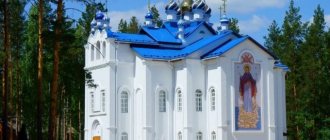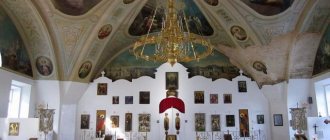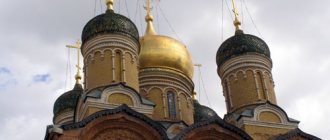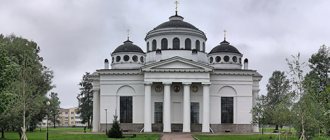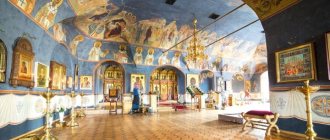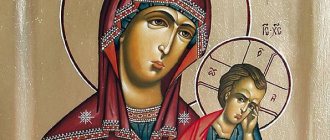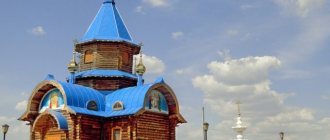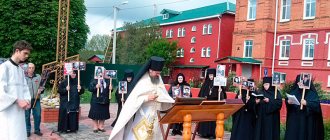History[edit]
St. Innokenty Irkutsk
The monastery was founded in 1689 on the right bank of the Angara. The first buildings were wooden, and by 1727, the Cathedral Church of the Sign, which was cut down in 1693, had fallen into disrepair. In 1762, the stone building of the monastery was rebuilt. The chapels and other objects were completed over several years.
On the night of February 6-7, 1920, the Supreme Ruler of Russia Alexander Kolchak and the Chairman of the Council of Ministers Viktor Pepelyaev were shot in the immediate vicinity of the monastery. With the arrival of Soviet power in Irkutsk, only the church building remains at the disposal of the local diocese, and the monastery is closed. Hydroaviation departments are located in religious premises: the Irkutsk hydroport has been located at the mouth of Ushakovka since 1928.
In 1926, the Znamensky Church became a parish church, and from 1929 it began to serve as a cathedral, since the Cathedral of the Epiphany was completely closed to religion, and the Kazan Cathedral was completely demolished. Seven years later, the Znamensky Church is closed again; its buildings house aircraft repair shops and garages.
With the beginning of the war, the Irkutsk hydroport stopped passenger transportation, pilots and aircraft were mobilized. The monastery only had NKPS seaplanes left, which served the BAM. The Znamenskaya Church was returned to the diocese in 1945. In 1948, its status as a cathedral was also returned. In 1953, the NKPS seaplane base was closed.
On August 30, 1960, by Decree of the Council of Ministers of the RSFSR No. 1327 (Appendix 1), the complex of the Znamensky Monastery was transferred to the rank of architectural monuments of republican (federal) significance and placed under state protection.
Since 1991, the relics of St. Innocent of Kulchitsky have again rested in the Znamenskaya Church, and on August 27, 1994, the rite of monastic tonsure was revived in the monastery. Currently, the diocesan administration of the Irkutsk Metropolis is located on the territory of the monastery.
Current state
In 1960, the monastery was placed under state protection as a historical and cultural monument. True, by this time not many buildings remained from it:
- Znamensky Church with three chapels, one of which, Preobrazhensky, is very dilapidated;
- holy gates;
- abbot's corps;
- monastery wall.
The building of the diocesan administration in the Znamensky Monastery
Currently, it is a functioning monastery, where the first tonsure was performed in 1994. The monastery is also the spiritual center of the Irkutsk diocese, since the Church of the Sign is a cathedral in which the ruling bishop often serves.
The origin of the monastery
History has preserved the name of the main organizer and leader of all work. It was a resident of Irkutsk, Vlas Sidorov. Emperor Peter I himself, noting the significance of this construction, granted the Gospel to the monastery. It is still kept in the monastery. But the wooden churches of the monastery deteriorated over the years, and so another generous donor, the merchant Bechevin, founded the stone cathedral with his own funds. Its construction lasted for many years. Various changes were repeatedly made to the architecture of the cathedral, additional extensions were built and the decorative design was changed.
But the flow of funds from philanthropists did not dry out. In 1886, the wealthy Irkutsk heiress A. N. Portnova allocated a huge sum for the construction of a stone two-story building that housed the cells of nuns and novices, and by that time there were one hundred and twenty souls. So, thanks to donations from city residents, the Znamensky Monastery grew and developed. Irkutsk is the heart of Siberia, and Siberia has always been famous for its generosity.
Activities of the parish
The Znamensky Monastery is not a parish in the literal sense of the word, but as one of the main monasteries of Irkutsk, it performs all the functions of the parish and is active in all spheres of life.
- The monastery provides spiritual care for the Irkutsk Orthodox Gymnasium.
- Volunteers visit an orphanage and boarding school.
- There is a Sunday school at the monastery.
A monument to Admiral Kolchak was erected on the territory of the monastery to commemorate the anniversary of his death and respect for the memory of the fallen white officers during the Civil War.
Architecture Features
The modern appearance of the temple was formed as a result of additions to the volumetric composition throughout the 18th and first half of the 19th centuries. various extensions of chapels, porches and porches. The initial volumetric-spatial composition was distinguished by its brevity. The plan had a four-part division with a sequential arrangement along the east-west axis of the vestibule, refectory, temple and altar.
The Nikolaevsky chapel was adjacent to the north side (in 1760). The main altar in the name of the Sign of the Most Holy Theotokos was consecrated in 1762 and occupies the quadrangular core of the church. In 1773-1787, 1790, “at the expense of various pilgrims,” the Kazan chapel was built. The construction of the Preobrazhensky side chapel (in 1794) on the north side of the central pillar gave asymmetry and imbalance to the planning structure.
In 1830, a new stone porch with two stone tents on the sides was added to the church porch. In such a significantly changed form, the church has reached our time.
The architecture of the church is close to ancient Russian architecture, this is expressed in the decorative design of the facades: paired columns in the corners of the quadrangle, curls in the frame of the windows. At the same time, the monument bears elements of the “Siberian Baroque”. Its features were manifested in the ornamental treatment of wall surfaces. The use of developed cornice rods and relief compositions made up of a combination of simple figures gives specificity to the decorative decoration.
Opening of a hospital and orphanage for girls
In 1872, a hospital for monastics was opened within the walls of the monastery. She was known throughout Siberia. Znamensky Monastery, Irkutsk - the address to which suffering nuns and novices turned. Here they received medical care that was so rare in those years. In addition, the monastery opened a school at the women's religious school and a hospice house. Subsequently, several more schools for girls were opened, in which they studied not only literacy, but also church singing. Also, the great merit of the nuns was the founding of an orphanage for girls. It is known that in 1912 there were 44 people held there.
Shrines and landmarks
Despite the fact that the monastery was pretty much ravaged and destroyed, nevertheless, many artifacts and shrines have been preserved here.
- Elements of the old iconostasis.
- Gospel given by Peter I.
- Icon “Savior Pantocrator” in an original silver frame from 1791.
Graves of the Decembrists in the Znamensky Monastery
The preserved necropolis of the monastery is also unique. Here is the burial place of Grigory Shelikhov, the founder and head of the Russian-American trading company that developed Alaska and the western coast of North America. The Decembrists P. Mukhanov, N. Panova, exiled to Siberia, as well as the wives of the Decembrist Trubetskoy, Ekaterina Trubetskaya, were buried in the same cemetery.
Other temples in honor of the icon “The Sign”:
- Znamensky Cathedral in Tyumen
- Znamensky Church in Dubrovitsy, Podolsk
But the main shrines of the monastery are the holy relics of the Irkutsk bishops, glorified by the Church.
- Saint Innocent (Kulchitsky, 1680 - 1731). The first independent bishop of Irkutsk and Nerchinsk. Ordained bishop in 1727, he did a lot for Orthodoxy in the region and the education of the common people, although he ruled for a short time. After his death at the end of the 18th century, his remains were found incorrupt. And he was glorified in 1804. Since 1990, the relics have been in the Znamensky Church.
- Particle of St. relics of St. Sophrony (Kristalevsky), the third bishop of Irkutsk, ruling from 1753 until his death in 1771. His body remained unburied for 6 months, and there were no signs of decay. The saint's tomb burned down in 1917, all that remained was placed in a small reliquary, one of which is located in the Znamensky Monastery. The saint was glorified in 1918.
Important!
In the monastery cemetery there is the burial of the second Bishop of Irkutsk, Innocent II (Nerunovich), who ruled the diocese from 1732 to 1747 and was especially distinguished by his missionary activities among the pagan peoples of Siberia. In the monastery, near the southern wall of the temple, there is the grave of Valentin Rasputin, the great Russian and Soviet writer who died in 2015.
Epithymians of the monastery
But the main concern of the monastery was, of course, serving God. Life in it was built according to the rules of cenobitic Russian monasteries, the main task of which was to strengthen the faith and monastic feats. Love for God and neighbors was placed above all else. And in this field the Znamensky Monastery became famous. Irkutsk has historically been a place where many have lived who have previously run afoul of the law. These are both former criminals and political ones. Among them there were many women. The nuns of the monastery took care of their spiritual revival.
The monastery itself was a permanent place where the spiritual authorities sent the so-called epithymians, that is, women exiled and excommunicated for various reasons. They were kept at the monastery and used in the most difficult and dirty work. Caring for these unfortunate people provided an opportunity to show truly Christian love.
“State criminals” were also imprisoned here. One of them was the daughter of Artemy Volynsky, executed under Anna Ioannovna, Anna.
After the death of the Empress in 1740, she gained freedom and left the Znamensky Monastery. Irkutsk became the place from where Anna set off on the long journey back. As a token of gratitude to the sisters of the monastery for their love and heartfelt care, she sent them the altar Gospel in a precious setting from St. Petersburg.
Development of crafts in the monastery
It should be noted that the nuns of the monastery themselves did not sit idle. And although their primary task remained prayerful works and everything connected with the spiritual side of life, nevertheless, by the end of the 19th century they managed to create a large economic entity in the monastery. Sewing workshops were opened in which ceremonial and everyday priestly vestments were made. Various church utensils were also sewn, both for their own needs and for sale.
In addition, to replenish the budget, orders were accepted for sewing secular clothing for residents of Irkutsk. We even learned how to make shoes. The skill of the inhabitants of the monastery became widely known. And this is no coincidence. The nuns were fluent in a wide variety of sewing techniques. Among them are front, gold embroidery, embroidery with various types of satin stitch, beads and even precious stones.
